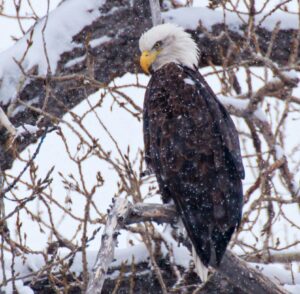The Bald Eagle nesting season is in full swing in the Rockies, and citizen scientists with Rocky Mountain Bird Observatory are busy monitoring nesting activity across Colorado. These volunteer scientists have already observed at least 20 eaglets in nests as of April 15, 2015, as part of Bald Eagle Watch.

Bald Eagle in Fort Collins, Colorado, by Stephanie Montgomery
Most of the nests being monitored by RMBO are along the Front Range, but in the last few years, the program has expanded elsewhere in the state thanks to interested citizens wanting to report the status of Bald Eagles in their neck of the woods. In 2015, Bald Eagle Watch citizen scientists are monitoring 32 nests in Colorado, including the nest at Barr Lake State Park northeast of Denver. To date, volunteers have observed two hatchlings in the Barr Lake nest.
The Barr Lake nest was first observed in 1986. At that time, the Bald Eagles occupying the nest were the only pair known to be nesting along the Front Range, and their nest was only one of 10 active nests in Colorado then. The Bald Eagle Watch program was founded to monitor this nest, which was a catalyst for the founding of Rocky Mountain Bird Observatory (then Colorado Bird Observatory) in 1988. Nearly 30 years later, citizen scientists continue to monitor the Barr Lake nest and many others in the state.
Bald Eagle Nesting Cycle
Bald Eagles along the Front Range typically lay 2-3 eggs at the end of February or early March. The parents incubate the eggs for about 35 days before hatching occurs. With most of the nests RMBO monitors, the female incubates the eggs for the majority of the time, but there are a couple nests where the male will take on the majority of incubation duties.
Usually, 1-2 eggs hatch, but occasionally eagles will have three eaglets in the nest at a time. Adult eagles will brood over the young for several weeks, especially in inclement weather. Within 2-3 weeks, the young eagles will begin to grow flight feathers and within 3-4 weeks they will be near full size. Fledgling birds generally depart the nest between 8 and 14 weeks after hatching.
Stay Tuned
We’ll be updating this post throughout the Bald Eagle nesting season, so check back often to see how the Barr Lake eaglets and others across the state are doing. If you’re interested in specific nests, please let me know by contacting me at (970) 482-1707 x25.
If you’d like to participate in Bald Eagle Watch, look for the volunteer callout at the end of the year for the 2016 season (the program is currently full for 2015). Training is typically held in January at RMBO’s Environmental Learning Center in Brighton.
~ Jeff Birek, Outreach Biologist


